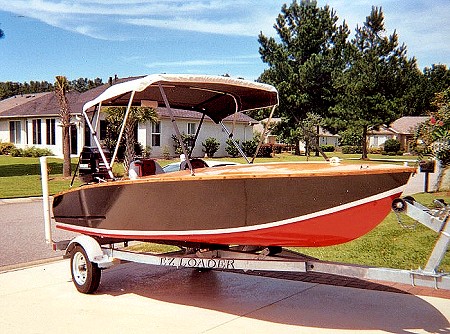Building the Glen-L Zip (Cont'd)
by Paul Vernes, Bluffton, South Carolina
I got my screws, etc. from Glen-L and I also used
Glen-L two-part Poxy-Grip throughout.
For flotation, I made up forms and pre-poured the foam into
shaped blocks that fit into the spaces between frames and
rest on top of the battens. This way the foam does not block
the limber holes and allows any water that gets into the
bilge to drain back. Total flotation is 5 cubic feet, which
is good for about 300 lbs. of crew/cargo. The floor caps all
this and is ½" exterior grade and provides a flat
floor throughout the cockpit.
I added the windshield this past winter at my wife's
request when she objected to the wind blast coming in over
the front deck. It is two laminations of ½" red
oak, epoxied together with ¼" Lexan for
glass.
When I was putting on the decking, I at first could not
decide between screws and ring nails for fasteners, but
finally chose the nails. This proved to be a great choice.
The bronze nails heads look great and I have had people who
come over to look at my boat remark how nice they look. Most
people think they are rivets. I would definitely use them
again and would never cover them up.
I did not use any fiberglass covering. I don't like
working with fiberglass and feel it is entirely unnecessary
if the boat is properly built. Also, once the covering is
breeched water will get behind it and rot the hull.
PERFORMANCE
The engine is a 1997 40-HP Mercury Classic in-line 4, the
last year this engine was built by Mercury. It is basically
the same as the 25-HP KG-9 introduced in 1949, the first
Mercury I owned, although vastly improved. In the 1960's
I also owned the 40-, 45-, and 50-HP versions of this
engine.
With this engine, before adding the windshield, my Zip would
do 41 MPH, according to my GPS. After putting on the
windshield, speed has dropped to just under 40 MPH. This is
with a 16 inch pitch 3-blade Mercury prop with the engine
turning 6000 RPM. At 188 pounds, however, the engine is
probably too heavy for this boat, as it sits stern deep at
rest and when I am in the back of the boat freeboard is only
about six inches. Great care is necessary in a following sea.
Other than that, performance is excellent.
Presently I am working on adding a step into the bottom of
the boat, similar to what was used in the 1930's on the
old Gar Wood Gold Cup boats. This is strictly an experimental
project designed to break the hull free from surface tension
with the water, and if it works should up my speed
substantially. Or, more importantly, allow for equal speed
with a smaller engine that uses less fuel.
I will keep you informed of my results.

See photos of Paul's build here